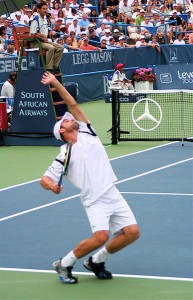Versailles and the Royal Sport
by Heather Pringle
August 14, 2009
 I should begin this week with a full and open disclosure.  I love the game of tennis, almost to distraction.  I love rising early on summer mornings and sneaking in an hour on the courts before temperatures soar.  I love plunking down in front of the flat screen to watch Andy Roddick rocket a scorching serve or Rafael Nadal dismantle his opponent with a deadly topspin. I love flipping through tennis magazines and scouring the sports sections for stories on the men’s and women’s tours. I love Wimbledon, the Rogers Cup, and Cincinnati. And I particularly love the U.S. Open, because it comes at the end of summer—the grand finale—and delivers more drama and last minute twists than any Hollywood blockbuster.
I should begin this week with a full and open disclosure.  I love the game of tennis, almost to distraction.  I love rising early on summer mornings and sneaking in an hour on the courts before temperatures soar.  I love plunking down in front of the flat screen to watch Andy Roddick rocket a scorching serve or Rafael Nadal dismantle his opponent with a deadly topspin. I love flipping through tennis magazines and scouring the sports sections for stories on the men’s and women’s tours. I love Wimbledon, the Rogers Cup, and Cincinnati. And I particularly love the U.S. Open, because it comes at the end of summer—the grand finale—and delivers more drama and last minute twists than any Hollywood blockbuster.
Tennis is an ancient sport with a fascinating pedigree.  Recently, French archaeologists uncovered the remains of an elegant 17th century indoor tennis-court at the Palace of Versailles.  This private court, constructed for Louis XIII around 1630, consists of a floor of a dressed limestone slabs  in a rectangular building measuring 108 feet long and 45 feet wide. (By comparison, a modern tennis court for doubles play measures 78 feet long and 36 feet wide, plus a surrounding clear space for overruns.)
Louis XIII was not the first tennis fanatic, however.  Historical and linguistic evidence both suggest that European monks played the game in the colonnaded walkways of their monasteries sometime in the 12th century.  Eventually French nobles picked up the sport, and by the early 1600s, Paris was tennis-mad.  Its citizens served and volleyed on an estimated 250 courts scattered across the city.  (This mania eventually subsided, however:  by the Industrial Revolution, only a dozen or so tennis courts could be found in all of France.)
The dig at Versailles should eventually tell us a lot about early tennis in France. The royal court included an apartment for the master paumier or ball maker, who served as a combination tennis coach, tournament organizer, and equipment manufacturer.  So debris from the apartment floors should reveal much about the paumier’s ancient craft. Historical records suggest that 17th century tennis balls were made of cork wrapped in tissue and then covered with hand-stitched felt.   Indeed the original pattern of handstitching is suggested by the wavy line on  modern balls.
I find it fascinating to trace the outlines of the ancient, invisible past in our daily lives today. Each time I serve to my opponent,  I  think of those long ago paumiers,  patiently stitching together bits of felt to make balls that spin across the court.
This entry was posted by Heather Pringle on
Friday, August 14, 2009.
Discussion of this blog entry is now closed.
Comments posted here do not represent the views or policies of the Archaeological Institute of America.

